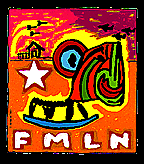


Military government have been in power most of the time since 1931, often responding to political unrest with violent repression. Political violence increased sharply after the 1977 election in which General Carlos H. Romero became president. He was deposed in October 1979, but the military-civilian junta that replaced him was unable to stop the civil war between leftists and rightist. As a concession to the left, the junta proposed a limited land reform that affected about 25% of the land. At the same time, the junta, which was closeley linked to the right through the army, did little to control the rightist paramilitary National Guard. As a result, archbishop Oscar Arnulfo Romero, associated with the left, was assassinated in 1980 by the rightist.


Under pressure from the U.S. to institute economic and human rights reform, the junta named Jose Napoleon Duarte, leader of the moderate Christian Democratic party, as president in December 1980. Although a small land-reform program was begun, fighting continued, as did rightist executions of farmers, peasents, and workers. The U.S. charging that the two main leftist groups, the Farabundo Marti National Liberation (FMLN) and the Revolutionary Democracy Front (FDR), were being helped by Nicaragua, Cuba, and the Soviet Union, increased its military and economic aid to the Salvadorian government (rightist) which were responsible for torturing and killing inocent people. In a 1982 election boycotted by the FMLN-FDR alliance, a constituent assembly was chosen to draw up a new constitution. Dominated by the rightist National Republican Alliance (Arena), the assembly curtailed the Christian Democratic land reform program. The new constitution was adopted in 1983, but in 1984, Duarte defeated Arena leader Roberto D'aubisson to win the presidency.


Despite various peace efforts, including El Salvador's participation in the 1987 Central America plan, the civil war continued. Duarte was succeeded as president on June 1, 1989 by Alfredo Cristiani of Arena. By 1990, as fighting and rights abuses surged and ebbed, the civil war had claimed more than 75,000 lives, mostly inocent people and thanks to military aid provided to the rightist National Guard by the U.S.. Agreement was reached in July 1990 that the United Nations monitor rights violations after a cease fire. UN sponsored negotiations continued, and on January 16, 1992, a peace accord was signed between the government and guerilla groups (FMLN). A cease fire went into effect on February 1. Under the agreement, the Salvadorian army was to be sharply reduced, the guerilla forces were to be absorbed in Salvadorian society, a new national police was to be created, and land reform measures enacted. In 1992 reconstruction began, under which the guerillas returned to civilian life in return for economic, social, and political reforms.


A United Nations commission announced in March 1993 that responsibility for the killings of thousands of Salvadorian civilians in the civil war must be assigned to senior military figures in the army, which were strongly backed by the United States and whom are still in power.


![[Back Home]](2homebutt83x34.gif)